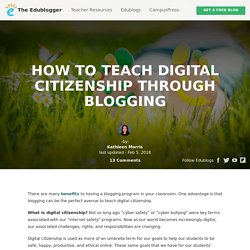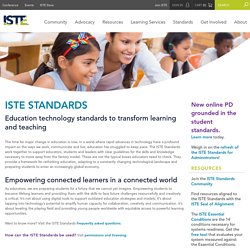

9 Tips for Using Technology to Differentiate Instruction. How To Teach Digital Citizenship Through Blogging. There are many benefits to having a blogging program in your classroom.

One advantage is that blogging can be the perfect avenue to teach digital citizenship. What is digital citizenship? Not so long ago “cyber safety” or “cyber bullying” were key terms associated with our “internet safety” programs. Now as our world becomes increasingly digital, our associated challenges, rights, and responsibilities are changing. Digital citizenship is used as more of an umbrella term for our goals to help our students to be safe, happy, productive, and ethical online. Common Sense Media’s curriculum identifies eight topics under the umbrella of digital citizenship including: internet safety, cyberbullying, copyright and more. Empowering your students with skills to think critically, behave safely, and participate responsibly online, allowing them to connect and collaborate in meaningful ways. Integration. Infusion. Immersion. Search Google for “Technology Integration” and you get nearly 2.8 million hits.

Search Google for “Technology Infusion” and you get more than 66,000 hits. Search Google for “Technology Immersion” and you get more than 25,000 hits. Based on this piece of admittedly non-scientific evidence, integration is still the operational zone of many, even though we’re 13 years into the 21st century. Among the 25,000 hits for immersion are articles that are really about integration. There are articles that suggest technology immersion doesn’t make much of a difference in students’ test scores. Not sure what I’m really talking about here? Integration is the equivalent of putting your toes in the water. Immersion is where we need to be, or at least be actively working toward.
In the article I mentioned above about technology immersion not making much of a difference in test scores, I wondered if the students were immersed in technologies for the school year, then assessed with pencil and paper? Kids Online. The Ultimate EdTech Chart for Teachers and Educators. 25 Easy Ways to Use Technology in the Classroom. Although many technology-based teaching methods and resources effectively engage students and build their skills, many educators encounter difficulties when using technology in the classroom. Maybe a specific platform is too hard to introduce.
Or maybe it won’t run on your devices. Despite the challenges, you likely want to enjoy the benefits that education technology can deliver. Using the ones that best apply to you and your students, and keeping the condensed list on your desk for quick reference, consider these 25 easy ways to use technology in the classroom: Offering a Unique Learning Experience 1. An ambitious way to use technology in the classroom, you can introduce a game-based learning platform. Most are designed to engage students, enlivening difficult topics and subjects. Prodigy is one, providing math content up to the 8th grade level that’s aligned with curricula across Canada, Australia, England and the United States. Create your free teacher account today!
2. Digital citizenship. Excerpted from Netiquette by Virginia Shea. The Core Rules of Netiquette are excerpted from the book Netiquette by Virginia Shea.

Click on each rule for elaboration. Introduction Rule 1: Remember the Human Rule 2: Adhere to the same standards of behavior online that you follow in real life Rule 3: Know where you are in cyberspace Rule 4: Respect other people's time and bandwidth Rule 5: Make yourself look good online Rule 6: Share expert knowledge Rule 7: Help keep flame wars under control Rule 8: Respect other people's privacy Rule 9: Don't abuse your power Rule 10: Be forgiving of other people's mistakes Next page ...Previous page ...Core Rules ...Netiquette Contents.
SAMR Model Explained for Teachers. A Guide for Bringing the SAMR Model to iPads. When used effectively, iPads can develop thinkers and problem solvers. They can be used to transform learning inside and outside of the classroom, and offer limitless opportunities. Many educators are effectively integrating technology in the classroom using iPads to achieve the 4C’s, or “super skills,” that digital learners need to compete in our global society. But in order to do that, the focus has to shift from apps to content: that’s when true redefinition takes place. When my district rolled out our iPad initiative in 2012, teachers thought they needed specific apps for every content area. Eventually, we ended up with literally thousands of apps in our portal. Are you ready to adjust your teaching for this new learning revolution? What’s the SAMR Model? The key to powerful and authentic technology integration is selecting digital tools that are appropriate for the task.
SAMR is like looking at a menu. Substitution: Same Task, New Tech Augmentation: Improve the Task with New Features. ISTE Standards. Education technology standards to transform learning and teaching The time for major change in education is now.

In a world where rapid advances in technology have a profound impact on the ways we work, communicate and live, education has struggled to keep pace. The ISTE Standards work together to support educators, students and leaders with clear guidelines for the skills and knowledge necessary to move away from the factory model. These are not the typical boxes educators need to check.